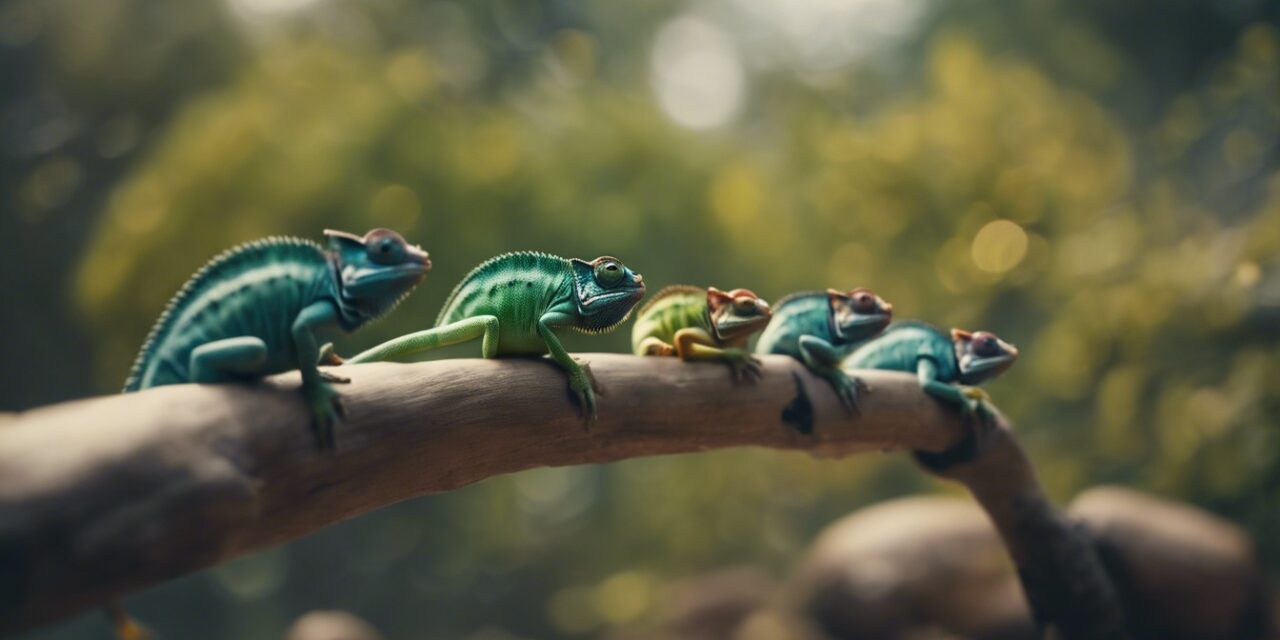Unveiling the Enigmatic World of Chameleons
Chameleons, with their unique abilities and captivating appearance, have long fascinated animal enthusiasts and nature lovers. These remarkable creatures possess a range of intriguing features that set them apart from other reptiles. In this section, we will delve into the mesmerizing world of chameleons and uncover five interesting facts about these enigmatic creatures.
Chameleons are known for their ability to change colors, but there is much more to these fascinating reptiles than meets the eye. From their color-changing marvels to their prehensile tail and independently rotating eyes, chameleons possess a myriad of adaptations that make them truly extraordinary.
Throughout this blog post, we will explore the intriguing information about chameleons and reveal captivating facts that will leave you in awe. Prepare to be amazed as we unravel the mysteries behind their color-changing abilities, discover how they communicate through chromatics, and understand the purpose of their prehensile tail.
So join us on this enthralling journey into the world of chameleons as we unveil their enigmatic nature and shed light on some of the most fascinating aspects of these incredible creatures.
The Color-Changing Marvels
Chameleons are renowned for their remarkable ability to change colors, a trait that has captivated scientists and nature enthusiasts alike. In this section, we will explore the fascinating world of chameleon color change and uncover the secrets behind this extraordinary phenomenon.
Adaptable Hues: The Art of Camouflage
One of the most intriguing aspects of chameleons is their ability to blend seamlessly into their surroundings through color change. This unique adaptation serves as a form of camouflage, allowing them to hide from predators and ambush unsuspecting prey. By altering the distribution of pigments in their skin cells, chameleons can match the colors and patterns of their environment with astonishing precision.
The process of color change in chameleons involves complex mechanisms within their skin cells. Specialized cells called chromatophores contain pigments that can be expanded or contracted, resulting in different hues. By manipulating these pigment alterations, chameleons can create an impressive range of colors, from vibrant greens and blues to earthy browns and yellows.
Communication through Chromatics
While camouflage is one purpose of color change in chameleons, it also serves as a means of communication. These reptiles use their vibrant displays to convey various messages to other members of their species. During courtship rituals or territorial disputes, male chameleons may exhibit bright and intense colors to assert dominance or attract potential mates.
In addition to visual communication, chameleons can also alter the intensity and pattern of their color displays to indicate emotional states such as aggression or fear. This intricate language of chromatics allows them to communicate effectively within their social groups without relying solely on vocalizations.
The ability to change colors not only showcases the incredible adaptability of chameleons but also highlights the complexity and sophistication of nature’s design. Through color change, these enigmatic creatures have mastered both the art of camouflage and the language of communication.
The Prehensile Tail: A Remarkable Adaptation
Chameleons possess a unique feature that sets them apart from many other reptiles—their prehensile tail. In this section, we will explore the incredible capabilities of this grasping appendage and how it aids chameleons in their arboreal lifestyle.
A Helping Hand: The Versatile Prehensile Tail
The prehensile tail of a chameleon is a specialized structure that acts as a prehensory extension, allowing these creatures to navigate their environment with remarkable agility. Unlike the tails of other reptiles, which primarily serve as balance or defense mechanisms, the chameleon’s tail is an essential tool for survival.
With its muscular and flexible nature, the prehensile tail enables chameleons to grasp branches and hold onto them securely. This adaptation provides them with stability while climbing and moving through trees. By coiling their tail around branches or using it as an anchor point, chameleons can maintain their position even on precarious surfaces.
Gripping with Precision
What makes the prehensile tail truly remarkable is its ability to grip branches with exceptional precision. Chameleons have specialized adaptations in their tails that allow them to exert varying levels of pressure on different parts of their tail. This control over grip strength enables them to adjust their hold based on the size and stability of the branch they are gripping.
Furthermore, the tail’s dexterity allows chameleons to move swiftly through complex arboreal environments. They can use their tail as a fifth limb, providing additional support and enhancing their maneuverability among branches. This versatility gives chameleons an advantage when hunting for prey or evading predators in their natural habitat.
The prehensile tail is just one of the many fascinating adaptations that make chameleons such incredible creatures. Its role in aiding these reptiles’ arboreal lifestyle showcases nature’s ingenuity and highlights how evolution has shaped these animals into masters of adaptation.
Eyes that See Beyond Imagination
Chameleons possess a visual system that is truly extraordinary. In this section, we will explore the fascinating abilities of their rotating eyes and how they provide these reptiles with a field of vision that goes beyond our imagination.
360-Degree Vision
One of the most remarkable features of chameleon eyes is their ability to see in multiple directions simultaneously. Unlike humans and many other animals, chameleons have a 360-degree field of vision. Their eyes are positioned on opposite sides of their head, allowing them to observe their surroundings without needing to turn their heads.
This panoramic view enables chameleons to be constantly aware of potential threats or opportunities in their environment. They can monitor predators, locate prey, and keep an eye on other members of their species, all without having to physically move their bodies.
Independent Eye Movement
In addition to their wide field of vision, chameleons’ eyes also have the remarkable ability to move independently from one another. Each eye can rotate and focus on different objects simultaneously, providing them with exceptional visual flexibility.
This independent eye movement allows chameleons to scan their surroundings for both predators and prey more effectively. They can track multiple targets at once, ensuring they never miss any potential danger or food source. This unique adaptation gives them a significant advantage in survival and enhances their hunting efficiency.
The combination of 360-degree vision and independent eye movement makes chameleons true masters of visual perception. Their eyes provide them with an unparalleled level of awareness and allow them to navigate complex environments with ease.
Chameleons: Masters of Camouflage
Chameleons are renowned for their incredible ability to blend seamlessly into their surroundings, making them nature’s illusionists. In this section, we will explore how these reptilian camouflage experts master the art of hiding from predators and ambushing their prey.
Blending In: Nature’s Illusionists
Chameleons have evolved a remarkable array of color-changing abilities that allow them to match their environment with astonishing precision. By altering the distribution of pigments in their skin cells, they can change colors rapidly and effectively disappear into their surroundings.
Different chameleon species have developed unique color palettes that enable them to mimic foliage, bark, or even rocks. This extraordinary adaptation helps them evade detection by predators and remain hidden from unsuspecting prey. Their ability to blend in seamlessly with their environment is truly awe-inspiring.
Changing with the Environment
What makes chameleons’ camouflage even more impressive is their capacity to adapt their coloration based on the changing environment. As they move through different habitats or encounter varying light conditions, chameleons adjust their skin colors accordingly, ensuring they remain virtually invisible.
This adaptive coloration not only aids in concealment but also serves other purposes such as thermoregulation. By altering the amount of light absorbed or reflected by their skin, chameleons can regulate their body temperature more efficiently.
The mastery of camouflage displayed by chameleons highlights the intricate relationship between these reptiles and their natural habitat. Their ability to change colors and blend in seamlessly with the environment showcases nature’s ingenuity at its finest.
Chameleons: An Ancient Lineage
Chameleons belong to an ancient lineage of reptiles that have been around for millions of years. In this section, we will explore the remarkable evolutionary adaptations that have allowed these prehistoric creatures to survive and thrive through time.
Evolutionary Marvels
Chameleons are truly marvels of evolution. Their unique characteristics and specialized adaptations have enabled them to occupy a diverse range of habitats across the globe. From rainforests to deserts, chameleons have successfully adapted to various environments, showcasing their incredible versatility.
One of the most notable evolutionary features of chameleons is their specialized feet. These reptiles possess zygodactyl feet, meaning their toes are arranged in a distinctive pattern that allows for efficient climbing and gripping onto branches. This adaptation has played a crucial role in their arboreal lifestyle and ability to navigate complex terrain with ease.
Additionally, chameleons’ independently rotating eyes and color-changing abilities are also remarkable evolutionary traits. These adaptations have provided them with enhanced visual perception and effective camouflage, ensuring their survival in ever-changing environments.
Survivors through Time
Chameleons have proven themselves as survivors throughout the ages. Fossil records indicate that these reptiles have existed for over 65 million years, adapting to changing climates and outlasting many other species. Their ability to withstand environmental pressures and persist through time is a testament to their resilience as a group.
Despite facing ongoing challenges such as habitat loss and climate change, chameleons continue to adapt and thrive in various regions around the world. Their ancient lineage serves as a reminder of the incredible diversity and longevity of life on Earth.
Unveiling the Mysteries of Chameleons
Throughout this blog post, we have delved into the fascinating world of chameleons and uncovered some captivating facts about these incredible creatures. From their color-changing abilities to their prehensile tail and rotating eyes, chameleons continue to amaze us with their remarkable adaptations.
By appreciating the intricate mechanisms behind their color-changing abilities, we gain a deeper understanding of how chameleons utilize this unique trait for camouflage, communication, and thermoregulation. Their ability to adapt their skin coloration to match their surroundings is truly astonishing.
The versatility of their prehensile tail has also been revealed, showcasing its role as a helping hand in their arboreal lifestyle. With precision gripping capabilities, chameleons can navigate through trees with ease and maintain stability on even the most challenging surfaces.
Furthermore, we have explored the mesmerizing abilities of chameleon eyes. Their 360-degree vision and independent eye movement provide them with an unparalleled field of view, enhancing their hunting efficiency and overall awareness in their environment.
Chameleons are not only masters of camouflage but also survivors through time. Their ancient lineage spans millions of years, demonstrating their resilience and adaptability in various habitats across the globe.
In conclusion, chameleons continue to captivate us with their intriguing information and captivating facts. Their unique abilities make them truly fascinating creatures that remind us of nature’s endless wonders. So let us appreciate these enigmatic reptiles for the remarkable adaptations they possess and continue to be amazed by the mysteries they unveil.










Recent Comments